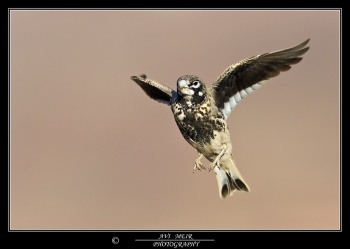m (→Distribution) |
(→Taxonomy: Update link) |
||
| (3 intermediate revisions by 2 users not shown) | |||
| Line 2: | Line 2: | ||
;[[: Category:Ramphocoris|Ramphocoris]] clotbey | ;[[: Category:Ramphocoris|Ramphocoris]] clotbey | ||
==Identification== | ==Identification== | ||
| − | 17cm. | + | 17cm (6.75 ins)<br /> |
| + | Short thick bill; projection on lower mandible fits into notch on upper mandible<br /> | ||
| + | *Pinkish or greyish-brown upperparts | ||
| + | *Large black spots on underparts | ||
| + | *Black face with a white patch in centre of cheek | ||
| + | *White throat and eye-ring<br /> | ||
| + | '''Females''' not so clearly marked with less streaking | ||
==Distribution== | ==Distribution== | ||
[[Image:03C9286 Thick-billed Lark.jpg|thumb|350px|right|Photo by {{user|A.+Meir|A. Meir}}<br />Arava valley, [[Israel]], March 2012]] | [[Image:03C9286 Thick-billed Lark.jpg|thumb|350px|right|Photo by {{user|A.+Meir|A. Meir}}<br />Arava valley, [[Israel]], March 2012]] | ||
[[Africa]] and the [[Middle East]]:<br /> | [[Africa]] and the [[Middle East]]:<br /> | ||
| − | Deserts of [[Western Sahara]], extreme | + | Deserts of [[Western Sahara]], extreme northern [[Mauritania]], south and south-eastern [[Morocco]], west and interior northern [[Algeria]], central and southern [[Tunisia]], north-western [[Libya]], central [[Jordan]], northern [[Saudi Arabia]]. An irregular and rare visitor to [[Egypt]]; a sporadic visitor to southern [[Israel]]; an uncommon winter visitor to southern and central [[Saudi Arabia]]; small numbers seen occasionally in western [[Kuwait]]; vagrant in southern [[Yemen]]. |
==Taxonomy== | ==Taxonomy== | ||
| − | This is a [[Dictionary_M- | + | This is a [[Dictionary_M-O#M|monotypic]] species<sup>[[#References|[1]]]</sup>. |
| + | |||
==Habitat== | ==Habitat== | ||
Dry shrubland and hot, stony deserts avoiding sand dunes. | Dry shrubland and hot, stony deserts avoiding sand dunes. | ||
==Behaviour== | ==Behaviour== | ||
| − | The diet | + | ====Breeding==== |
| + | Pebbles are used for nest building which the males presents to the female during display. The shallow nest is scraped out of the ground near a stone or bush, with a pebble ramp on one side. The 3 to 5 eggs are incubated by the female from March through to May. The young are tended by both adults. No information available on incubation or fledging times. | ||
| + | |||
| + | ====Diet==== | ||
| + | The diet consists of insects, seeds and plants. They use their strong bill to dig for seeds, which are swallowed whole. Grit is used to aid digestion. Forages singly or in small flocks. | ||
| + | |||
| + | ====Vocalisation==== | ||
| + | '''Male song''': from both the ground and in flight, consists of a rapid series of twittering notes and a medley of warbling and tinkling notes.<br /> | ||
| + | '''Calls''': include a sharp ''prit,'' usually in flight, plus ''wick-wick,'' ''sree,'' ''coo-ee,'' ''wheet-wheet-wheet,'' with an alarm call of a long plaintive whistle, ''tsu-ee''. | ||
| − | |||
==References== | ==References== | ||
| − | #{{Ref-Clements6thAug13}} | + | #{{Ref-Clements6thAug13}}#Handbook of the Birds of the World Alive (retrieved March 2014) |
| − | #Handbook of the Birds of the World Alive | ||
{{ref}} | {{ref}} | ||
==External Links== | ==External Links== | ||
Latest revision as of 19:55, 5 July 2014
- Ramphocoris clotbey
Identification
17cm (6.75 ins)
Short thick bill; projection on lower mandible fits into notch on upper mandible
- Pinkish or greyish-brown upperparts
- Large black spots on underparts
- Black face with a white patch in centre of cheek
- White throat and eye-ring
Females not so clearly marked with less streaking
Distribution
Africa and the Middle East:
Deserts of Western Sahara, extreme northern Mauritania, south and south-eastern Morocco, west and interior northern Algeria, central and southern Tunisia, north-western Libya, central Jordan, northern Saudi Arabia. An irregular and rare visitor to Egypt; a sporadic visitor to southern Israel; an uncommon winter visitor to southern and central Saudi Arabia; small numbers seen occasionally in western Kuwait; vagrant in southern Yemen.
Taxonomy
This is a monotypic species[1].
Habitat
Dry shrubland and hot, stony deserts avoiding sand dunes.
Behaviour
Breeding
Pebbles are used for nest building which the males presents to the female during display. The shallow nest is scraped out of the ground near a stone or bush, with a pebble ramp on one side. The 3 to 5 eggs are incubated by the female from March through to May. The young are tended by both adults. No information available on incubation or fledging times.
Diet
The diet consists of insects, seeds and plants. They use their strong bill to dig for seeds, which are swallowed whole. Grit is used to aid digestion. Forages singly or in small flocks.
Vocalisation
Male song: from both the ground and in flight, consists of a rapid series of twittering notes and a medley of warbling and tinkling notes.
Calls: include a sharp prit, usually in flight, plus wick-wick, sree, coo-ee, wheet-wheet-wheet, with an alarm call of a long plaintive whistle, tsu-ee.
References
- Clements, J. F., T. S. Schulenberg, M. J. Iliff, B.L. Sullivan, C. L. Wood, and D. Roberson. 2013. The eBird/Clements checklist of birds of the world: Version 6.8., with updates to August 2013. Downloaded from http://www.birds.cornell.edu/clementschecklist/download/
- Handbook of the Birds of the World Alive (retrieved March 2014)
Recommended Citation
- BirdForum Opus contributors. (2024) Thick-billed Lark. In: BirdForum, the forum for wild birds and birding. Retrieved 27 September 2024 from https://www.birdforum.net/opus/Thick-billed_Lark





